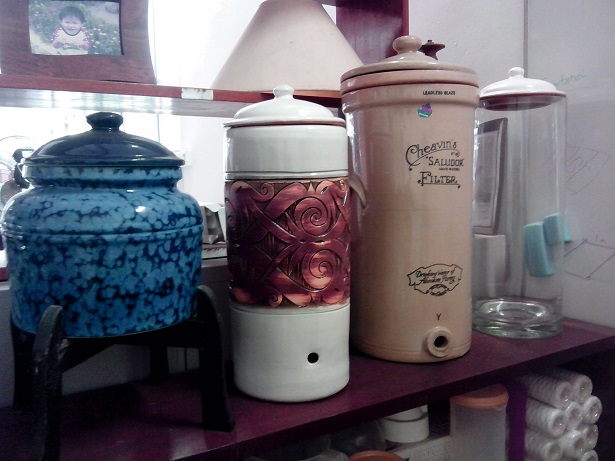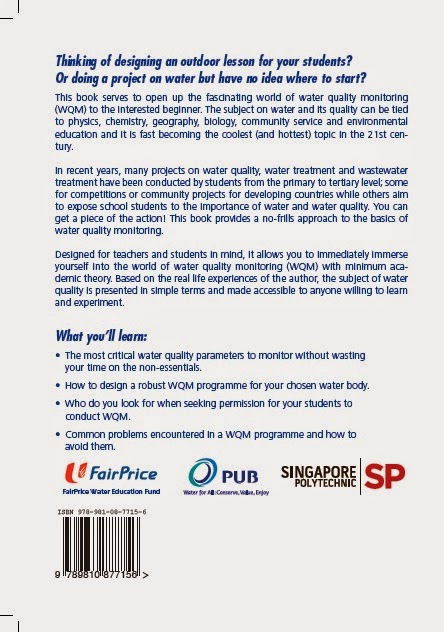I would like to check if you have heard about Tami Water
system - Strauss Water.? Searching through your blog, I could find topics on UV
treated water.
Would like to hear your professional opinion about UV
sterilize water treatment, is it necessary in Singapore ? prolong exposure to
UV treated water is it safe?
The BB system you mentioned looks a bit bulky for most kitchen top though I really like stainless steel products. Looking for a convenient and safe water filtration system.
Sorry I don't know how to pose questions via your blog.
Thank You and Best Regards,
R
Hi R,
Personally, I do not see the need for a water filter for Singapore tap water. The water is already quite clean so any filter will be hard pressed to clean it further. (See this post and others in the filter/purifier tag.) Unless you suspect your pipelines and/or water tank are somehow contaminated. Still, it will be easier to call your residential management to take care of it. Or unless you have a medical condition that requires very clean water to be consistently provided.
A small note on water parlance: "sterilisation" means the destruction of all microbes while "disinfection" means the significant reduction of microbes. Water is normally "disinfected" to make it safe for drinking. It is not practical and necessary to sterilise water for drinking. Sterilisation is usually done in medical applications (e.g. sterilising surgical tools), microbiological setting (e.g. incubation for bacterial count) or pharmaceutical manufacturing.
As for UV (ultraviolet) treatment of water for drinking, you probably have already guessed my opinion that it is similarly not necessary for Singapore tap water.
How does UV work?
UV disinfects by disrupting the DNA in microbes (aka bugs). If the DNA is sufficiently damaged (enough contact time or UV power or both), the microbe cannot repair that damage and its bodily functions will be affected, leading to a halt in reproduction or death.
In case anyone thinks I am against UV, let me proclaim that I am a fan of UV treatment in the situations that it is necessary. Its main advantage is it is a relatively simple system to operate. You just need to plug into a power supply and you are good to go. No messy chemicals to resupply, no need to calculate dosage of chemicals and no chemical waste to fuss over its disposal. UV can work under any temperature and pH. These are two master parameters which will invariably affect any water treatment involving chemical reactions. You do not need to worry over the undesirable generation of disinfection by-products (DBPs) including potentially carcinogenic chloroform in the case of chlorination.
Even though UV treatment has been worded as "UV radiation" or "UV irradiation", there is absolutely no ionising radiation (e.g. X-rays) involved so no way will your water become radioactive. UV is generally safe for water disinfection.
Remember the bugs you killed or injured by UV earlier. Though they can no longer reproduce, their dead and dying cells are still in the water. There is some concern these cells can be pyrogenic (fever causing) or become food for other bacteria further downstream. Nevertheless, unless your dead/dying cell count is very high, I believe this should not be an issue.
Of course, you have to be aware of UV's limitations as well. UV is only for disinfection of bugs in your water. It does not remove metals, pesticides, solvents and other chemical substances. (Admittedly, UV does destroy certain organic compounds but most UV units are not designed for this function. Even those experimental ones designed for this function are usually combined with other methods e.g. ozonation, addition of hydrogen peroxide.)
UV also does not leave any residual in the water after treatment. Let's say chlorination - it leaves chlorine residuals in the water long after leaving the water treatment plant. Enough to last till the water comes out of your tap. In between treatment and your tap, the residuals prevent recontamination by microbes as the water flows through pipes, pumps, valves and whatnot. Not so for UV, your water is on its own after UV treatment unless you intentionally add chemicals e.g. chlorine, chloramines, for that purpose. (Hmmm.... that kind of defeats the purpose of using UV, doesn't it?)
One big challenge of using UV is your inflowing water has to be very clear (turbidity of less than 1 NTU for the techies out there). If your water contains solids e.g. clay, sediment, the bugs will hide behind these solids and receive shielding from the full power of your UV light.
Yes, you do not have to resupply chemicals in UV treatment BUT you have to replace the UV lamp periodically as it will lose its power over time.
Finally, the lamp may be fouled over usage. Grime, dirt, debris can stick to the lamp and these stuff prevents your UV light from shining out effectively. Cleaning then becomes an important part of maintenance. Industrial UV setups usually have their lamps protected by removable sleeves. Even then, the sleeves themselves can be fouled and thus have to be cleaned as well.
End of UV talk
Tami Water, Strauss Water... No, I haven't heard of them but I made a quick search and took a look at their webpages. They seemed like an aesthetically packaged water filter (carbon blocks + UV) that can provide both hot and cold water. As I said earlier, you don't really need water filters in Singapore. Unless you are interested in their hot/cold water combo function. But looking at the price (S$1200 for the Tami Primo model), I don't think that is the most efficient use of your money.
If you really must get a water filter, Arkwater does provide one in stainless steel housing a Doulton ceramic filter. It is pretty slim and designed for countertop use. (Let me stress that I do not derive any benefits from the sale of their products.)

Figure: My trusty Steripen portable UV water treatment unit. Note the UV lamp on the left end.

Figure: Disinfection in action. Notice the bluish light at the lamp. It is supposedly safe for the eyes as the UV cannot escape from the water surface. It takes 1 minute to disinfect 0.5L of clear water. If your source water is murky, it pays to at least sieve your water through a clean piece of cloth or coffee filter before going to UV.






No comments:
Post a Comment